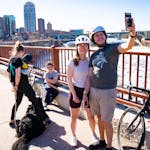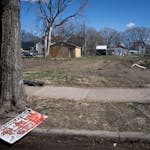The release Thursday of video and audio exhibits from the murder trial of Mohamed Noor gave the first broad public viewing of the evidence prosecutors used to convict the former Minneapolis police officer of fatally shooting Justine Ruszczyk Damond.
The approximately three dozen pieces of evidence made public by the court ranged from Damond's two 911 calls about a possible sexual assault behind her south Minneapolis home to several body camera videos recorded by officers who arrived after Noor killed Damond in 2017.
The release came after weeks of legal fights between a coalition of media partners and the court, which sought from the beginning of the case to limit public access to the trial and about 300 pieces of evidence.
Prosecutors raised the specter of police secrecy at trial, noting that several officers at the scene only spoke to investigators after they were subpoenaed to appear before a grand jury. They also scrutinized body camera use, and the video evidence showed repeated concern at the scene for Noor and his right to not speak about the shooting, even while efforts continued to save Damond.
The evidence included body camera video from officer Jesse Lopez, one of the first officers at the scene.
"Just keep to yourself," Lopez told a visibly distraught Noor. "Keep your mouth shut until you have to say anything to anybody."
It also included three videos from Noor's supervisor, Sgt. Shannon Barnette, who turned her camera on and off multiple times that night, including during a conversation with Noor.
A recording also captured Barnette leaving a voicemail on Damond's cellphone as her body lay on a driveway in an alley. Damond's identity hadn't been confirmed at that point.
"Hey Justine, this is Sgt. Barnette, Minneapolis police," she said. "Say I know you called in the unknown trouble call of a woman screaming and I have a question for you, it's pretty important."
In another video, officer Joseph Grout is heard telling someone his body camera is recording: "I'm hot right now. I don't know if we're s'posed to be or not."
Five graphic body-camera videos showing Damond gasping for breath as first responders tried to save her life were not part of Thursday's release. Those videos and all other evidence in the case will be made available for public viewing in the Hennepin County Government Center on Friday.
Hennepin County District Judge Kathryn Quaintance ruled Wednesday that the five videos — recorded by Noor, his partner, Matthew Harrity, and three other officers — can only be publicly distributed as copies once the state redacts some of the imagery and audio.
Lawyer Bob Bennett, who negotiated a $20 million settlement for Damond's family, said the videos were "tremendous" in making his case.
"The blue wall of silence is alive and well," Bennett said of the content of the videos. "Who were they protecting and serving?"
Joseph Daly, an emeritus professor at Mitchell Hamline School of Law, had a similar view about the impact of the body-camera videos.
"I think the public is going to see a conspiracy of silence," said Daly. "The public's going to look at this and say, 'Is this what police officers do all of the time when they get in trouble? They tell them to keep their mouth shut?' "
Lt. Bob Kroll, president of the Minneapolis police union, said he hadn't seen the videos. The department declined to comment.
Al Berryman, a past Federation president, said he found nothing unusual about the officers' caution while the cameras were on.
"You don't wanna say something [on camera] and make yourself look stupid or make the other person look guilty," said Berryman.
Noor and Harrity were responding to Damond's 911 call when Noor fired from the front passenger seat through Harrity's open window.
Noor testified at trial that a loud bang on the squad car startled Harrity, who struggled to draw his gun as Damond appeared at Harrity's window. Noor said he shot because he feared they were being ambushed.
"Sarge, Sarge," Harrity said as he rapidly approached Barnette while officers continued lifesaving efforts on Damond, according to her body-camera video. "We had the call over here, someone was screaming in the back, we pulled up here, we were about ready to clear and go to another call she just came up out of nowhere on the side of the thing and we both got spooked. I had my gun out, I didn't fire and then Noor pulled out and fired."
Jurors convicted Noor on April 30 of third-degree murder and second-degree manslaughter. He is set to be sentenced June 7.
While body-camera videos have been used to clear some officers of wrongdoing in fatal shootings, veteran defense attorneys said Noor's case appears to be Minnesota's first test of the technology's application in a major criminal trial.
Minneapolis police began a body-camera pilot program in 2014. St. Paul police began using them in late 2017.
Attorneys who watched body-camera videos from Noor's trial for the first time Thursday said the evidence provided context that cannot be replicated.
"The quality of this is outstanding," said defense attorney Joe Friedberg. "Not only that, it's pretty effective in getting across people's state of mind at the time. There's obviously abject confusion out there" at the shooting scene.
Defense attorney Marsh Halberg, who attended parts of Noor's trial, said it could set an "informal precedent."
"It shows how powerful body cameras can be in terms of showing the details and nuance in the moment," Halberg said. "Everybody will point to this in the future. It's going to be used as an argument in the future if any other court doesn't allow public viewing [of body-camera videos] in court."
Halberg's prediction isn't without cause. Quaintance ruled against a request by Noor's lawyers to play a video about implicit bias during jury selection, noting that her peers had no experience with it. She also banned the prosecution from introducing two3-D videos of the crime scene created by the Minnesota Bureau of Criminal Apprehension using advanced laser technology.
The attorneys and Daly said that while body-camera videos can be helpful, it's also easy to misread video. Daly and Friedberg said they were less bothered by Lopez's advice to Noor.
"To a lawyer like myself, that's exactly what's supposed to happen," Friedberg said. "If you care for your compatriot or your client or your friend, you tell him to shut your mouth. He cannot help himself by speaking. He can only hurt himself."
Staff writers Rochelle Olson and Libor Jany contributed to this report.


